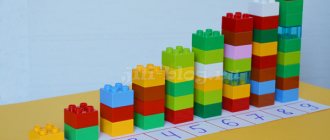How to make mathematics interesting for a child? How to play it? How to develop logical thinking in a child?
Many adults associate mathematics with numbers and number operations, which is why children are often taught numbers and counting first. But it’s better not to start forming mathematical thinking from this place.
We adults are accustomed to operating with letters, numbers, diagrams - we have developed abstract thinking. A child’s thinking is structured differently—psychologists call it figurative. Indeed, children explore the world using all five senses: touch, taste, smell, sound and looking at it. So, first of all, they need to let them “touch” mathematics. And the easiest way to do this is in everyday affairs and in games.
Mathematics is a creative science and fun to play. Mathematical games help a child take a fresh look at the world, pay attention to those processes and patterns that he had not noticed before. Mathematical thinking enriches the personality, makes life more interesting and rich. The main objectives of primary mathematics education are to teach the child to make independent conclusions, find patterns and solve logical problems.
What to teach first?
- First of all, it is worth teaching your child the relative position of objects : “to the right”, “to the left”, “above”, “below”, “behind”, “in front”. We live in a three-dimensional world, and it would be good to help a child build a model of this world. There are many games on this topic: robot games, labyrinth games, simple programming games.
- The second important skill is to classify objects by characteristics : first by one, then by two, and so on. For example: put red cubes in one pile, blue ones in another. This will be classified by color. We add a classification by size: large red figures in one bucket, small red ones in another, large blue ones in a third. You can also introduce a classification according to the shape of an object and, as a result, introduce the child to geometric shapes.
- It is also useful to teach your child to measure the lengths of objects . You can measure in meters and centimeters, but it is better to first use various measuring objects: cars, dolls, then palms, steps. And compare which is longer and in what way. For example, the length of a python can be measured in apples, parrots, or equal steps. Or you can outline the outline of the child’s body on a piece of whatman paper, and then measure it with different measuring toys. Through this technique, the child will easily learn the relativity of measurements, and it will be clearly visible to him that comparison can only be made if the lengths are measured by the same standards.
- The best way to enter numbers is by counting quantities and measuring lengths. It is also important to show the child the difference between the number of an object (for example, the sixth apple) and the quantity (six apples).
- And only after the child has thoroughly mastered the concept of quantities can he be taught mathematical operations : addition, subtraction, division and multiplication.
What are math puzzles?
These are entertaining tasks with game elements. Such tasks do not require deep mathematical knowledge and special training; rather, you will need intelligence and observation.
There are a lot of math puzzles. These include logical puzzles, problems with numbers and pictures, paradoxes and probabilities, and much more. They can be simple, which the child can easily cope with on his own, or complex, when he needs the help of his parents.
Development and education of children from 2 to 11 years old in a playful way
Start practicing right now
Start practicing
How we play math
We have been playing math games with our children since early childhood, from the age of 3. The first was the game “Kitten's Journey”.
My son picked up a toy kitten, we sat down in front of the globe, and the journey began. We imagined that a fast train was rushing a kitten from our city across the entire continent, and tried to imagine the pictures that the kitten sees. Along the way, the kitten had to draw a path through a maze, or collect precious stones in a cave, or help a little beaver build a house. Of course, our son helped the kitten complete the proposed tasks. Sometimes we “boarded” into a rocket and flew to the stars, exploring them, the planets and space itself. Sometimes we shrank down to microscopic size and traveled through the blood vessels of the human body, studying the composition of the blood and the location and properties of the body's organs. The son grew, the tasks became more complicated. His next favorite game was Lego Programming. We drew labyrinths through which, by issuing commands “forward”, “backwards”, “right”, “left” with four colors of Lego blocks, we had to guide a robot or car. At the same time, there were many games for classification and sorting of objects.
Then a math club was organized for children aged 4-6 years old - we spent two years together playing and learning new things. Then our daughters were born, after them new games appeared and the old ones were enriched. Finally, we collected what we had accumulated over ten years of study into a book. Each chapter begins with a story about how dad or mom play with their children - Kolya and Katya. You can discuss the games from the story with your child, you can play them, or you can complete the tasks suggested at the end of the chapter.
Here are some games from this book.
Four cars
An example of a visual game for sorting objects by color.
- Dad, I'm bored! Play with me! - Kolya called his father. - Fine. What are we going to play? - In Lego. - Amazing. Would you like me to show you something interesting? - Dad sat down opposite Kolya and poured out all the Lego between them. Then dad took four trucks from the shelf and suggested: “We have Lego parts in four colors.” Let's arrange them among the cars: the first one will carry red parts, the second one will carry blue parts, and the next two will carry yellow and green parts. We will take the parts to the other end of the room and there we will build four garages from them: red, blue, yellow and green.
Robot in the maze
This game is aimed at developing algorithmic thinking. This is how we learn to solve complex problems using a sequence of simple actions.
- Kolya, imagine that you are a robot. Stand here, on the arrow showing the entrance to the labyrinth. You should only walk when you hear the command, and take one step at a time in the direction indicated to you. Katya will manage you.
The guys were happy and agreed. Then dad put Kolya in front of the entrance to the maze, and Katya next to Kolya, and said that the robot only understood simple commands: forward, backward, right and left; and that at each command he takes a step in the indicated direction and freezes, waiting for the next command. And that he cannot enter squares on which there are obstacles.
Multi-colored candies (logic problem)
Mom: - I bought you three candies: green, red and yellow. For Katya - not green, for Kolya - not yellow, for dad - neither red nor green. Guess which candies I bought for whom.
Practical material for parents “Math games at home” (5–6 years old) card index
“Math games at home” (5–6 years old)
Numbers. Check
Game “My funny ringing ball” (with a ball)
For example, an adult calls the number 4 (throws the ball) and says:
- “Count further” (and so on with any number up to 10).
- Name the neighbors of the number 4 (5, 6, 9, etc.)
- Name the number that follows the number 2 (3, 4, 6, etc.)
- Name a number that is 1 more (or 1 less than the one named).
Counting in a chain (one at a time).
- The adult starts with “one,” the child continues with “two,” the adult with “three,” the child with “four,” etc. until 10. Then the child starts counting first.
Game “Put aside the same number of objects (counting by ear)
The adult claps his hands rhythmically, the child closes his eyes and counts the claps by ear, then puts away the same number of objects.
- Question: How many items did you put aside? Why?
- Complication: Count 1 more objects (or 1 less than you hear claps.
- Question: How many items have you put aside? Why?
Game "Count the same amount"
There is a large number of objects in front of the child (sticks, circles, buttons, etc.)
- Task: Count out 4 buttons (or any other number up to 10, or count out as many sticks as the number shows (while the adult shows the child any other number within 10).
Game "Wonderful Cup"
Necessary equipment: ten yogurt cups, a small toy that fits in the cup.
- Label each cup with a number.
- Choose a driver. He must look away. During this time, hide a toy under one of the glasses.
- The driver turns and guesses which glass the toy is hidden under. He asks: “Under the first glass? Under the sixth? and so on until he guesses correctly.
- You can answer with prompts: “No, more,” “No, less.”
Game: “Which number is missing?”
- In front of the child is a number row. The child closes his eyes or turns away, the adult removes one or two numbers. Opening his eyes, the child determines which number is missing.
Game: “The numbers are running wild”
All numbers are arranged randomly. Give your child the task of putting the numbers in order.
Connect the number with the required number of objects using an arrow.
Circle the number that corresponds to the number of items.
Game "Name the Number"
In front of the child is a number row. The adult invites the child to show any of the named numbers, or pointing to any number and ask what it is called.
- Tell me which numbers are missing 1 34 6 8 10?
- What number should go instead? 1? ? 4 5? 7? 9 10? and etc.
Game "Guess the number"
The game helps prepare children for basic mathematical operations of addition and subtraction, helps strengthen the skills of determining the previous and subsequent numbers within the first ten
- Ask, for example, which number is greater than three but less than five; what number is less than three but greater than one, etc.
- Children love to guess numbers and guess what they have in mind. Think of a number within ten, for example, and ask your child to guess it. The kid names different numbers, and you say whether the named number is greater than or less than what you had in mind.
- Then switch roles with your child.
Geometric figures
Distinguish and name the shapes: circle, square, triangle, rectangle, trapezoid, rhombus, oval.
Game “Put the object in its place”
There are objects on the table.
- Assignment: round objects - on a round shelf, oval objects - on an oval shelf, etc. (denoting the shelf with the corresponding geometric figure)
Game "Shapes"
Required equipment: counting sticks (or matches).
- Tell your child about basic geometric shapes. Explain what a side and an angle are.
- Together with your child, start making geometric shapes from sticks. Then ask him to do it himself.
- You can give it the required dimensions based on the number of sticks. Invite him, for example, to fold a rectangle with sides of three sticks and four sticks; triangle with sides two and three sticks.
- Try making shapes of different sizes, with different numbers of sticks.
- Teach your child to compare shapes.
- Another option is combined figures, in which some sides will be common. For example, from five sticks you need to simultaneously make a square and two identical triangles, or from ten sticks you need to make two squares - a large and a small one (a small square is made from two sticks inside a large one).
- By combining counting sticks, the child consolidates knowledge of mathematical concepts: “number”, “more”, “less”, “same”, “figure”, “triangle”.
Orientation in space
Game: "Find the object"
Any toys are located in the room (near the sofa, behind the chair, in front of the flower, behind the shelf, on the table)
- Tasks: Find a bunny near the sofa. There's a typewriter behind the chair. In front of the flower is a doll. There's a book behind the shelf. There are notebooks on the table.
- Questions: Where was the bunny? Where was the car? Doll? Book? Notebook?
- Complication: Place the bunny in front of you (behind, left, right, under, near)
Game: "Planes Landing"
In front of the child is a sheet of paper and small airplanes (made of cardboard or toys)
- Tasks: The plane flies to the upper right (left) or lower corner. Where is the plane? The plane flew into the middle of the sheet. Where is the plane? Etc.
- You can play similarly with a puck (black cardboard circle). The puck flies in different directions. Where's the puck?
Game tasks for children
- Stomp your right foot three times.
- Touch your left ear with your left hand.
- Raise your right (left) hand up.
- Place your right (left) foot on your toes.
- Touch your right knee with your left hand.
- Turn to the right (to the left).
- Take three steps forward, turn left, take five steps, etc.
Time orientation
Season
- Know the name of the current season.
- How many seasons are there in total? Name them in order.
- What season comes after spring? etc.
- Name the winter months.
Parts of the day (what we do in the morning; when we walk, sleep, have lunch, wake up, do exercises, etc.)
Days of the week
- What day of the week is the 2nd (3rd, 5th, 6th)?
- Today is Tuesday. What day will it be tomorrow?
- Sunday – what day is it?
- What day of the week will be after Wednesday?
- What day is between Monday and Wednesday?
- How many days are there in a week?
Good luck to you and your children!
Perform developmental exercises from Ikyusha
Mathematics
Reading
The world
Logics
English language
Puzzle “Card, please”
Look carefully at the credit card numbers. What three numbers should be written in place of the question? Already have any guesses?
We hope you completed the task quickly! And the next puzzle is already waiting for you.
Puzzle “Chairs”
The teacher asked the students to arrange 9 chairs along the four walls of the classroom so that each wall had three chairs. The students completed the task. Can you?
Puzzle “House number”
Hardworking builder Evgeniy arrived on site earlier than the others, but forgot the house number! We know that the house is located between plots 88 and 98. Can you help Evgeniy and tell him the number?
Bullseye Puzzle
Do you like to watch archery competitions? It's so exciting! Look, both archers have already performed, let's count how much archer B scored? We know that shooter A scored 54 points, and points are earned proportionally from the end: 1, 2, 3...
Puzzle “Mom and Daughter”
In this task you need to guess the ages of the mother and daughter. We know that if you add up their ages, you get the number 66. And if you swap the numbers of the mother’s age, you get the exact age of the daughter. Moreover, the mother is no older than 59, and the daughter is no younger than 7. Guess how old they are?
Puzzle “Hurray, fireworks!”
Look how beautiful the fireworks are! And not just one, but six! But one of them was not launched, determine which one?
Puzzle “Mathematics”
The task is simple - fill out each line and column so as to get the specified result at the end. You can only use numbers from 1 to 9 so that there are no repetitions in each line.
Puzzle “Wise Old Man”
The father of three sons made a will so that after his death the children would divide their father's herd of camels like this: the eldest son would take half, the middle son only a third, and the youngest son would get only a ninth. The father died, leaving a herd of 17 camels. Unable to divide the animals, the children asked the wise old man to help them. The elder agreed and, arriving on his camel, divided the animals according to his will. How did he do it?
This puzzle is a variation of Italian mathematician Niccolò Tartaglia's famous "Difficult Inheritance" problem. He went down in history as the scientist who discovered the solution to cubic equations.
Puzzle “Counting fruits”
Where else if not in a store to train counting skills? Let's buy 2 sweet aromatic oranges? How many coins will you need to pay for them? Look at the picture and count.








